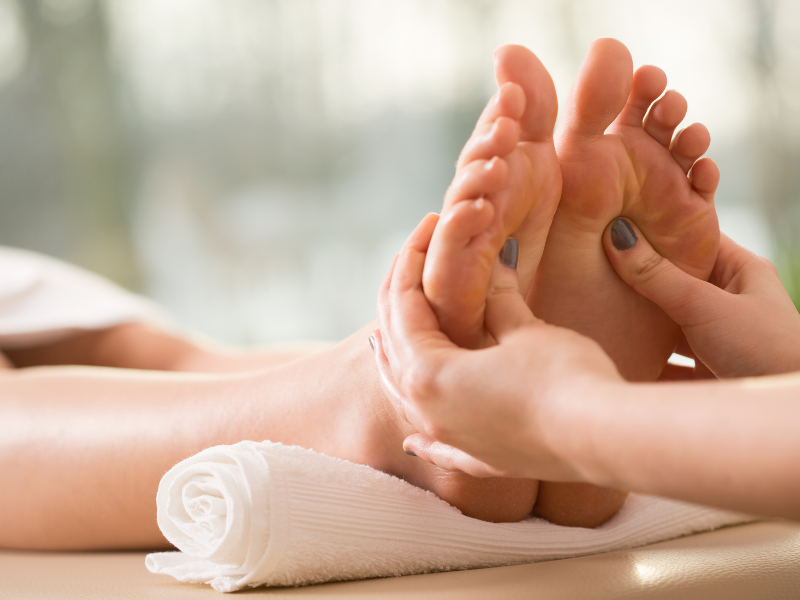If I told you that pressing on certain spots in your feet could actually help your liver or ease a sore neck, you might think I’m crazy. And that’s totally fair! How can something on your foot affect other parts of your body? If you’re not skeptical, you might be really surprised, and if you’re not shocked, you probably already know about reflexology.
What is Reflexology?
Reflexology is a study that suggests there are specific “zones” or reflex areas on our hands and feet that connect to all the organs, glands, and systems in our bodies.
According to reflexology, putting pressure on these areas using your thumbs, fingers, and hands can help reduce stress. This decrease in stress is believed to lead to many positive changes in the body that can help with different health issues.
Exploring the Benefits of Pressure Points in Your Feet
Reflexology is not just for people who are feeling unwell; it can also be great for those who are generally healthy. Here are some cool ways that the pressure points in your feet can be helpful:
- Eases pain
- Helps your nerves work better
- Gives you more energy
- Improves blood flow
- Gets rid of toxins
- Stops migraines
- Cleans out your urinary system
- Helps you heal faster from injuries
- Aids in better sleep
- Lowers feelings of depression

Reflexology Foot Massage: Pressure Points in Your Feet
Now that you understand how reflexology can help improve your health, let me guide you on how to do it yourself with an easy foot massage!
- First, find a comfy but sturdy chair to sit in. Lift one foot and place it on the knee of your other leg so you can easily massage the bottom of that foot. Remember to keep your back straight and avoid slouching.
- Next, check out your Acupressure Foot Chart (you can find it below or click here) to see which part of your body you want to focus on. For instance, if you have neck pain, look for the number that corresponds to the “neck” area. Then, find the matching spot on your foot in the chart that has the same number. That’s the spot you’ll be working on.
- Once you’ve located the right area on your foot, use your thumb to press and knead that spot firmly for about 1-2 minutes. After that, switch to your other foot and use your other thumb to do the same.
- You can repeat this for any other areas on your body that you want to help!

Reflexology: Taking Your Foot Massage to the Next Level
Now that you’ve learned the basics of reflexology and how it works, let’s delve a little deeper into some additional tips and techniques to make the most of your foot massage:
Tips for an Effective Reflexology Session
- Relax First
Before beginning your massage, take a few minutes to relax. Deep breathing or soaking your feet in warm water can help loosen muscles and prepare your body for the treatment. - Use Oil or Lotion
To avoid friction and make the massage more comfortable, consider applying a small amount of massage oil or lotion to your feet. This will allow your thumbs and fingers to glide smoothly over the skin. - Be Gentle but Firm
Reflexology should never be painful. Apply firm but gentle pressure to each area, and always stop if you feel any discomfort. - Take Your Time
Spend at least 5–10 minutes on each foot to fully benefit from the practice. Rushing through the massage can make it less effective. - Stay Hydrated
Drinking water after your reflexology session can help flush out toxins released during the massage.

Key Reflex Points to Focus On
- The Toes
The tips of your toes correspond to your head and neck. Massaging these areas can help relieve headaches or neck tension. - The Arch of the Foot
This area is linked to your stomach, liver, and pancreas. Kneading the arch can support digestion and alleviate stress-related discomfort. - The Heel
The heel connects to your lower back and sciatic nerve. Applying pressure here may help ease lower back pain or sciatica. - The Ball of the Foot
This area is associated with your lungs and chest. Massaging the ball of your foot can improve circulation and help with respiratory issues.
Regular Practice for Lasting Benefits
Reflexology works best when practiced regularly. You can make it a part of your nightly routine or use it as a quick self-care remedy when you’re feeling stressed or tired. Over time, you may notice improvements in your overall well-being.
Reflexology isn’t a substitute for medical treatment, but it’s an excellent complementary practice that can support your health naturally.

Discover More About Reflexology
If you’re interested in exploring reflexology further, there are plenty of online resources, videos, and charts available to guide you. Some practitioners also offer in-person reflexology sessions for a more professional approach.
Try it today and experience the calming, healing effects for yourself! And don’t forget to share this article with your friends and family—they might thank you for introducing them to this simple but powerful wellness technique.
